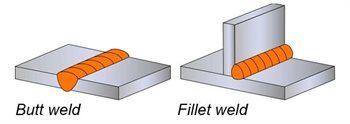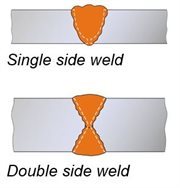

Welding is a fabrication process whereby two or more parts are fused together by means of heat, pressure or both forming a join as the parts cool. Welding is usually used on metals and thermoplastics but can also be used on wood. The completed welded joint may be referred to as a weldment.
Some materials require the use of specific processes and techniques. A number are considered ‘unweldable,’ a term not usually found in dictionaries but useful and descriptive in engineering.
The parts that are joined are known as a parent material. The material added to help form the join is called filler or consumable. The form of these materials may see them referred to as parent plate or pipe, filler wire, consumable electrode (for arc welding), etc.
Consumables are usually chosen to be similar in composition to the parent material, thus forming a homogenous weld, but there are occasions, such as when welding brittle cast irons, when a filler with a very different composition and, therefore, properties is used. These welds are called heterogeneous.
The completed welded joint may be referred to as a weldment.
As opposed to brazing and soldering, which do not melt the base metal, welding is a high heat process which melts the base material. Typically with the addition of a filler material.
Heat at a high temperature causes a weld pool of molten material which cools to form the join, which can be stronger than the parent metal. Pressure can also be used to produce a weld, either alongside the heat or by itself.
It can also use a shielding gas to protect the melted and filler metals from becoming contaminated or oxidized.
A connection between the ends or edges of two parts making an angle to one another of 135-180° inclusive in the region of the joint.
A connection between the end or edge of one part and the face of the other part, the parts making an angle to one another of more than 5 up to and including 90° in the region of the joint.
A connection between the ends or edges of two parts making an angle to one another of more than 30 but less than 135° in the region of the joint.
A connection between the edges of two parts making an angle to one another of 0 to 30° inclusive in the region of the joint.
A connection in which two flat plates or two bars are welded to another flat plate at right angles and on the same axis.
A connection between two overlapping parts making an angle to one another of 0-5° inclusive in the region of the weld or welds.

Joint between two overlapping components made by depositing a fillet weld around the periphery of a hole in one component so as to join it to the surface of the other component exposed through the hole.
Weld made by filling a hole in one component of a workpiece with filler metal so as to join it to the surface of an overlapping component exposed through the hole (the hole can be circular or oval).

Welded joint where the weld metal fully penetrates the joint with complete root fusion. In US the preferred term is complete joint penetration weld (CJP, see AWS D1.1).

Weld in which the fusion penetration is intentionally less than full penetration. In the US the preferred term is partial joint penetration weld (PJP).

Butt weld
Fillet weld
Metal to be joined or surfaced by welding, braze welding or brazing.
Metal added during welding, braze welding, brazing or surfacing.
All metal melted during the making of a weld and retained in the weld.
The part of the parent metal metallurgically affected by the weld or thermal cutting heat, but not melted.
Boundary between the weld metal and the HAZ in a fusion weld. This is a non-standard term for weld junction.
Zone containing the weld metal and the HAZ.
The surface of a fusion weld exposed on the side from which the weld has been made.
Zone on the side of the first run furthest from the welder.
Boundary between a weld face and the parent metal or between runs. This is a very important feature of a weld since toes are points of high stress concentration and often they are initiation points for different types of cracks (eg fatigue cracks, cold cracks).
In order to reduce the stress concentration, toes must blend smoothly into the parent metal surface.
Weld metal lying outside the plane joining the toes. Other non-standard terms for this feature: reinforcement, overfill.
Note: the term reinforcement, although commonly used, is inappropriate because any excess weld metal over and above the surface of the parent metal does not make the joint stronger.
In fact, the thickness considered when designing a welded component is the design throat thickness, which does not include the excess weld metal.

The metal melted or deposited during one passage of an electrode, torch or blowpipe.
Stratum of weld metal consisting of one or more runs.
Different processes are determined by the energy source used, with a variety of different techniques available.
Until the end of the 19th century, forge welding was the only method used, but later processes, such as arc welding, have since been developed. Modern methods use gas flame, electric arc, lasers, electron beam, friction and even ultrasound to join materials.
Care needs to be taken with these processes as they can lead to burns, electric shock, damaged vision, exposure to radiation or inhaling of poisonous welding fumes and gases.
There are a variety of different processes with their own techniques and applications for industry, these include:
This category includes a number of common manual, semi-automatic and automatic processes. These include metal inert gas (MIG) welding, stick welding, tungsten inert gas (TIG) welding also know as gas tungsten arc welding (GTAW), gas welding, metal active gas (MAG) welding, flux cored arc welding (FCAW), gas metal arc welding (GMAW), submerged arc welding (SAW), shielded metal arc welding (SMAW) and plasma arc welding.
These techniques usually use a filler material and are primarily used for joining metals including stainless steel, aluminium, nickel and copper alloys, cobalt and titanium. Arc welding processes are widely used across industries such as oil and gas, power, aerospace, automotive, and more.
Friction welding techniques join materials using mechanical friction. This can be performed in a variety of ways on different welding materials including steel, aluminium or even wood.
The mechanical friction generates heat which softens the materials which mix to create a bond as they cool. The manner in which the joining occurs is dependant on the exact process used, for example, friction stir welding (FSW), friction stir spot welding (FSSW), linear friction welding (LFW) and rotary friction welding (RFW).
Friction welding doesn’t require the use of filler metals, flux or shielding gas.
Friction is frequently used in aerospace applications as it is ideal for joining otherwise ‘non-weldable’ light-weight aluminium alloys.
Friction processes are used across industry and are also being explored as a method to bond wood without the use of adhesives or nails.
This fusion joining process uses a beam of high velocity electrons to join materials. The kinetic energy of the electrons transforms into heat upon impact with the workpieces causing the materials to melt together.
Electron beam welding (EBW) is performed in a vacuum (with the use of a vacuum chamber) to prevent the beam from dissipating.
There are many common applications for EBW, as can be used to join thick sections. This means it can be applied across a number of industries from aerospace to nuclear power and automotive to rail.
Used to join thermoplastics or pieces of metal, this process uses a laser to provide a concentrated heat ideal for barrow, deep welds and high joining rates. Being easily automated, the high welding speed at which this process can be performed makes it perfect for high volume applications, such as within the automotive industry.
Laser beam welding can be performed in air rather than in a vacuum such as with electron beam joining.
This is a fast process which is commonly used in the automotive industry. This process can be split into two types, resistance spot welding and resistance seam welding.
Spot welding uses heat delivered between two electrodes which is applied to a small area as the workpieces are clamped together.
Seam welding is similar to spot welding except it replaces the electrodes with rotating wheels to deliver a continuous leak-free weld.

Tunaak Metals Nigeria Limited is a structural steel fabrication company, which specializes in fabrication of all type of structures, ranging from storage tanks, industrial and marine pipping and miscellaneous steel structures in the civil, industrial and marine sectors. With innovative ideas in steel fabrication we build world class products for a better community. We provide essential and specialize training for our staff to enable us go beyond the expectations of our clients, while implementing adequate safety measures which protects the environment and persons.